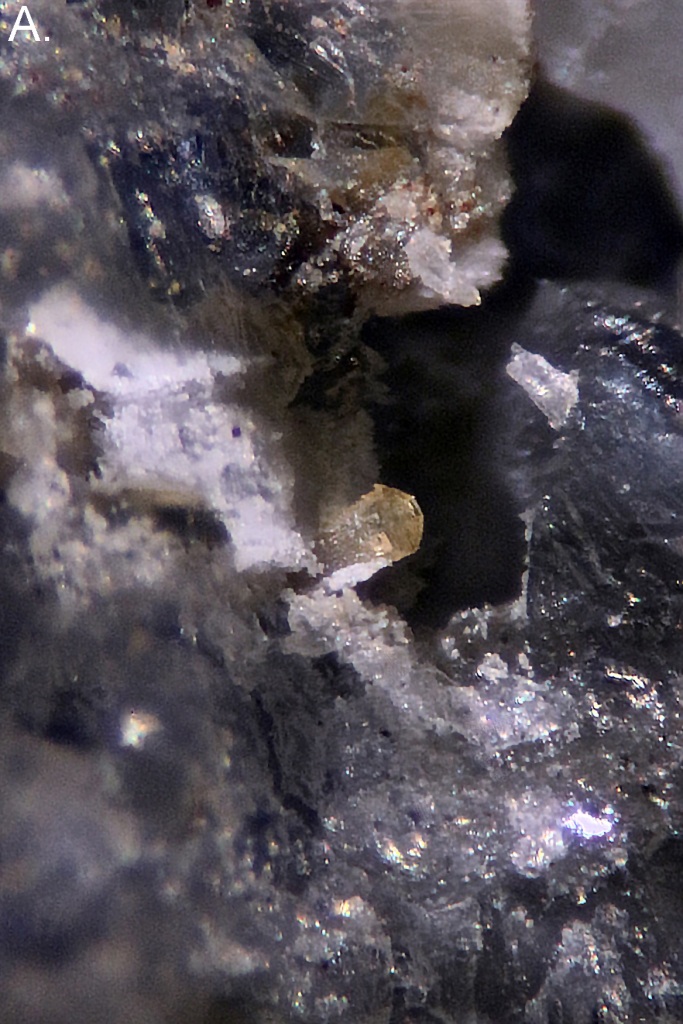In August 2021, an opportunity arose to visit a new mining claim in British Columbia. After two years of travel restrictions due to Covid-19, there was no hesitation. A chance to get out into the field and inspect a new sodalite deposit in the mountains? When do we leave?
Skip ahead a few months. Glenn Poirier and I find ourselves at 6,000 feet elevation in the Rocky Mountains, high above the chalky waters of the Blaeberry River 35 km north of Golden, British Columbia. Perched precariously on the algae-covered logs that dominate Mount Mather Creek, we are excited to be collecting samples of bright blue sodalite from a breccia composed of both syenite and carbonatite—an interesting mix for sure.
The Mount Mather Creek sodalite claim is part of the British Columbia Alkaline Province, which includes famous mineral localities such as the Ice River Alkaline Complex and the Rock Canyon REE-F-Ba deposit. Much of this geological province is of interest to mining companies as it contains economic deposits of rare elements such as niobium, tantalum and the rare-earth elements (REE). With >70% of global production of REE coming from China and >90% of the world’s Nb resources coming from Brazil, it is imperative that Canada begins to position itself as a global “supplier of choice” for these critical elements.

The claim is leased by Chris Robak, a mineral dealer from Red Deer, Alberta. Chris was excited to have us visit his property to assess the extent of the deposit and determine its mineralogy and genesis. Earlier in the year, fighting the spring melt and snow-pack that was still present on the mountain, Chris and his team extracted 10 tonnes of sodalite-bearing material from boulders along the creek bed to be used for lapidary material.

The Mount Mather Creek sodalite locality is a unique type of intrusion called a carbohydrothermal deposit—a cross between a true carbonatite (a rare rock with >30% carbonate minerals by volume) and a hydrothermal deposit (formed from hot or supercritical fluids). At Mount Mather Creek, the intrusion caused extensive fracturing of the surrounding country rock, resulting in a composite dike consisting of a carbonatite matrix (veins and sweats of carbonate-rich sodalite syenite), along with fragments of host rock. Glenn, Chris and I spent a week exploring and mapping the exposure and collecting samples to bring back to the Museum.

Back in the lab, many hours were spent at the microscope and using X-ray diffraction to identify all the minerals present in the rock samples. When we first visited the claim, a total of 6 minerals were known to occur at the locality, and so we were surprised to discover that the Mount Mather Creek sodalite claim is host to a much larger suite of minerals, many of them quite rare and unique! We identified a total of 23 known and one potentially new mineral species. The dominant minerals are sodalite, ferroan dolomite, calcite and microcline, but there is also a large suite of microminerals enriched in REE, Na, Ba and Sr, including albite, several zeolites (analcime, natrolite, chabazite-(Na), gonnardite and edingtonite), ancylite-(Ce), fluorapatite, baryte, barytocalcite, cancrinite, galena, goethite, pyrite, quintinite and sphalerite. Many of these species are typical minerals found in alkaline intrusions worldwide, such as Mont Saint-Hilaire in Quebec.

Included in this list is quintinite—Mg4Al2(OH)12CO3•3H2O—a rare Mg-Al-CO3 layered double hydroxide (LDH). Quintinite is named after Ottawa-based mineral collector and micro-mineral photographer extraordinaire Quintin Wight (b. 1935). Quintinite was originally discovered and described from Mont Saint-Hilaire, Quebec, by retired Carleton University mineralogist Dr. George Chao and retired CMN mineralogist Robert Gault. Mount Mather Creek is only the 2nd Canadian occurrence of this mineral.

At Mount Mather Creek, quintinite is found in small vugs within the sodalite syenite, associated with chabazite-(Na), secondary calcite, ancylite-(Ce), microcline and sodalite. It is translucent, light yellow in colour, and occurs as pseudohexagonal prisms up to 150 x 100 µm (average: 70 x 40 µm). Crystals are capped with an epitactic overgrowth of quintinite, creating what looks like a “trunk” and a “cap” to the crystals.

Quintinite at Mont Saint-Hilaire occurs in altered pegmatite veins as tabular, hexagonal, transparent yellow, vitreous crystals up to 1 mm in diameter. The crystals often form rosettes or stacked aggregates. It is associated with analcime, natrolite, paranatrolite, gonnardite, annite, aegirine, calcite, siderite, fluorite, pyrite and ancylite-(Ce)—many of the same minerals found at Mount Mather Creek.

Although Mount Mather Creek and Mont Saint-Hilaire are of different ages and occur in completely different geological environments, the underlying processes that form these unique and complex rocks are the same. As a result, the magmas from which these two intrusions form had similar chemistries—enriched in sodium, potassium, fluorine, carbonate and rare elements, while being depleted in silicon. Why does quintinite only occur at the two localities in Canada? It’s because of the unique chemistry of the magma, but we still have some work to do to figure out why.


